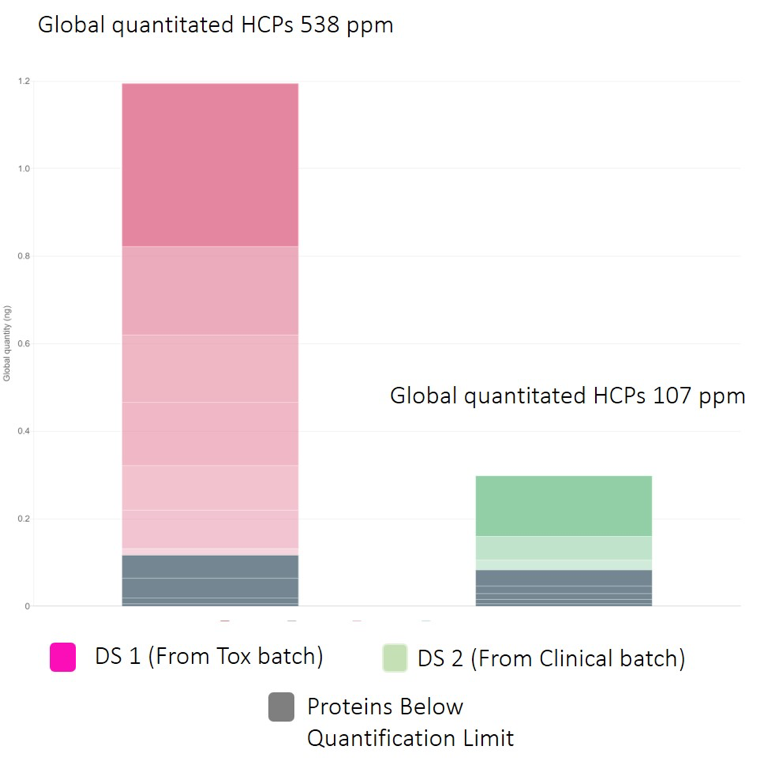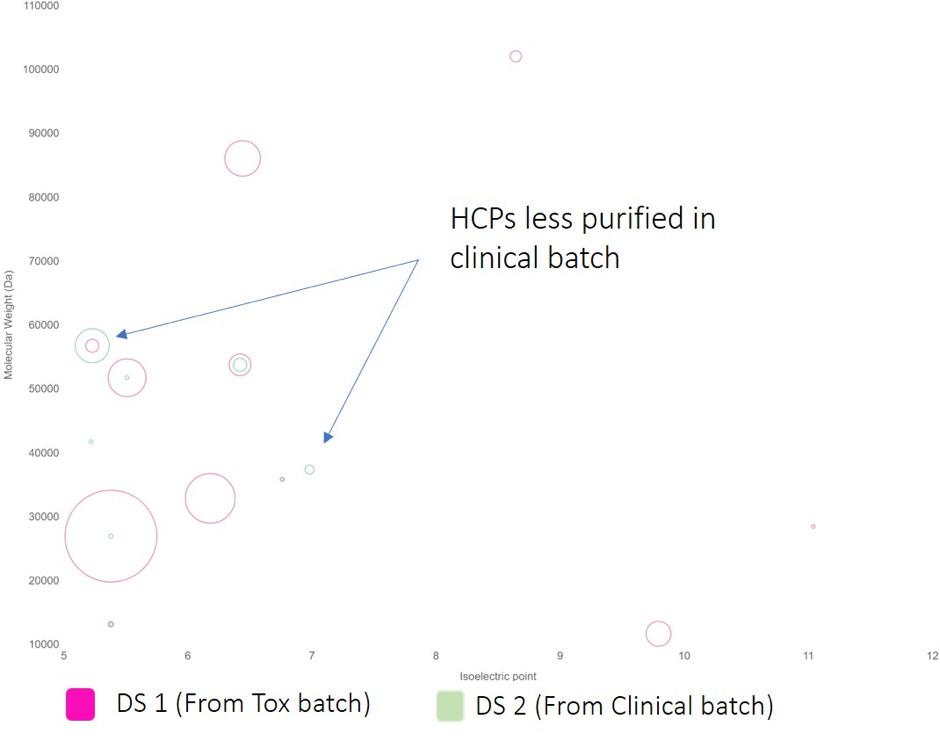Introduction & strategy
Many therapeutics are produced in CHO cell lines. When biopharmaceutical companies develop new Biologics, they usually go through different steps including Bioprocess optimization, with the ultimate goal to increase production yield and purity of the drug product. To obtain a better drug substance, it usually requires to modify production and/or purification processes. But changing these settings could cause the opposite effect and alter product purity or efficiency. Host Cell Proteins (HCP) are a critical attribute to monitor, since they can be involved in product degradation, or be responsible of immunogenic effects. Thus, HCP identification is an essential way to explore to drive the downstream process but also the upstream process optimizations.
HCP identification and quantification using MS based approach is now considered as an essential orthogonal method to ELISA kit for HCP profiles establishment, since this technique gives the possibility to individually identify HCPs. Consequently, focus can be done on some risky HCP which can involve immunogen effects or drug product degradation. ANAQUANT has developed an innovative solution dedicated to Host Cell Protein analysis: the HCP-PROFILER. This solution is composed by both (1) a READYBEADSTM coated with a universal standard, which, after being spiked directly into the sample, releases peptides at well controlled amount to obtain directly a calibration curve; and (2) a dedicated software to convert MS signal into amount of protein and to improve data consistency and sample comparison.The developed HCP-PROFILER represents a technical solution for batches comparison (consistency) and DSP/USP process performances studies regarding HCP removal (figure 1).
In this application note, we use HCP-PROFILER to compare HCP profiles before and after upstream process modifications. Comparison was done between a toxicologic batch (used for toxicological study and produced at smaller scale) and clinical batch production (industrially produced), both purified using same DSP.

Figure 1: HCP profiler integrated workflow
Results
The real added-value of HCP-PROFILER solution is to allow simultaneously identification and accurate assessment of individual HCPs quantity. Moreover, according to its normalization capabilities, HCP-PROFILER allows production batches comparison, at a quantitative level through time and at each step of the downstream process. Thus, comparison of quantification results was done for both, clinical batch and batch dedicated to toxicological studies (Tox batch) (Figure 2).

Figure 2: Global HCP quantification in both DS using HCP profiler solution.
Results demonstrated that global HCP quantity but also individual HCPs are impacted by Upstream process modifications.
First, production process scale-up appears to have a significant impact on the global HCP quantity in drug substance samples. Indeed, a 5-fold difference was observed between clinical batch and Tox batch.
However, the observed drop in total HCP amount for clinical batch is HCP-dependant. Indeed, in spite of lower global HCP amount in the clinical batch, some HCPs appeared to be at higher level in this latter compared to the Tox batch (Figure 3). These observations highlight the complex metabolic modifications that occurred when USP was slightly modified, and that are reflected by the HCP analysis. Consequently, it also reminds the importance to monitor HCP at individual scale, all along the development of both USP & DSP. Finally, the individual HCP identification/quantification allowed by HCP-PROFILER MS-based approach appeared an essential information particularly for risky proteins.
Figure 3: HCPs comparison between two production batches. Pink: Tox batch and Green: clinical batch. Graphic representative of HCPs pI function of HCPs molecular weight, size of circle is dependant to protein quantity
Conclusion
This study proved the power of our innovative solution HCP-PROFLER to monitor USP modification consequences on total amount of HCP and also at on individual amount of each HCP. Results demonstrated that few changes can greatly impact the HCP profile. Consequently, it highlights that HCPs must be monitored during both the downstream process development but also the upstream process evolution. Finally, results demonstrated the power of HCP-PROFILER approach to individually identify and quantify HCPs in DS sample but also suggest it efficiency to compare results over the time, with an easy and straightforward analytical approach.
 Anaquant HCP analysis I Protein characterisation I Protein analysis
Anaquant HCP analysis I Protein characterisation I Protein analysis